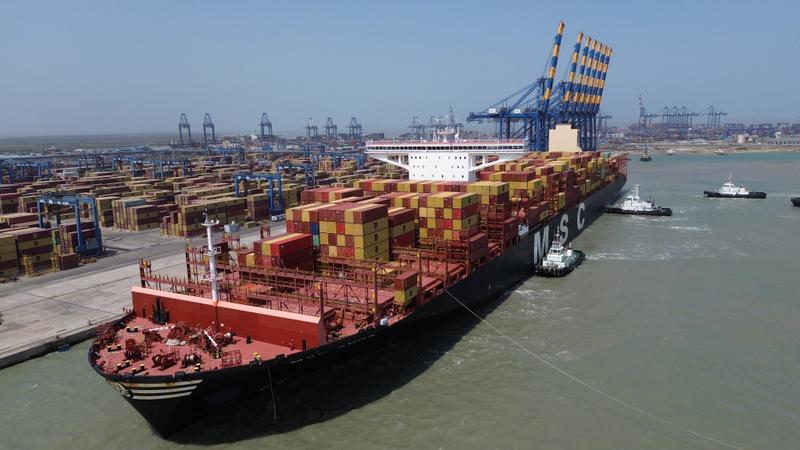Published 13:52 IST, September 15th 2024
Freight Costs,ontainer shortages threaten India's exports: GTRI
Freight costs, container shortages threaten India's exports: GTRI

GTRI on India's exports: Increasing freight costs, shortage of containers and dependence on major shipping hubs and foreign carriers pose serious challenges to the country's exports, think tank GTRI said on Sunday.
To address these challenges, the Global Trade Research Initiative (GTRI) recommended that India implement several strategies to boost domestic container production, enhance the role of local shipping companies, promote the use of domestic containers, and strengthen local shipping firms.
"India can lower its risk of global supply chain disruptions by boosting domestic container production, encouraging the use of locally made containers, and increasing the use of Indian shipping companies for transporting goods," GTRI Founder Ajay Srivastava said.
Between 2022 and 2024, shipping rates for a 40-foot container have fluctuated significantly.
It said that in 2022, the average cost was $ 4,942 due to the lingering effects of the covid pandemic, while by 2024, the rate had stabilized around USD 4,775, it said adding that these rates are still significantly higher than pre-pandemic levels, where the cost was $ 1,420 in 2019. "The elevated freight rates reflect the persistent supply chain challenges that continue to burden global trade," Srivastava said.
He added that there had been unverified reports of China hoarding containers to maximize its exports to the US and Europe ahead of potential trade restrictions and a hike in duties on solar panels, electric vehicles, steel, and aluminium manufactured by Chinese firms located in China or elsewhere like in ASEAN (Association of Southeast Asian Nations) countries.
However, the real container shortage issue likely stems from broader logistical inefficiencies like port congestion and Red Sea disruptions rather than deliberate stockpiling, Srivastava said.
Freight costs for Indian exporters shipping goods to Europe and the US have more than doubled in the past year, driven by disruptions in the Red Sea.
The GTRI said that last month, delays in ship arrivals at India port were caused by congestion at Singapore port.
"Indian exporters may soon face another disruption if the US-China trade war escalates in the coming months," it said.
The global container shortage, first triggered by the COVID-19 pandemic, may soon reemerge, causing severe difficulties for Indian exporters.
"To minimise Trade Disruptions Due to US-China Trade War Escalation and other geopolitical events, India must invest in Container Production and Domestic Shipping," it added.
It also said that India's dependence on major shipping hubs and foreign carriers significantly increases costs and risks.
"To cut costs and minimise risks, three key logistics challenges need urgent attention. First, 90-95 per cent of India's cargo is transported by foreign shipping liners, giving them control over access and freight rates, limiting India's ability to manage costs and schedules," it suggested.
About 25 per cent of India's cargo is transshipped through hubs like Colombo, Singapore, and Klang, increasing transit time and freight costs.
India depends heavily on containers made in China, making it vulnerable to supply disruptions and price fluctuations, it said adding "India's dependence on major shipping hubs and foreign carriers significantly increases costs and risks".
The shipping container industry is critical to global trade, and India has been making efforts to expand its container production.
However, the GTRI said that current output is insufficient to meet growing demand.
India produces between 10,000 and 30,000 containers annually, while China, the global leader, produces around 2.5 to 3 million containers per year.
This leaves India with less than 1 per cent of the global market share, making it vulnerable to disruptions in container availability.
"The ownership of shipping containers is dominated by major shipping lines and leasing companies with negligible share of India. Companies like Maersk (Denmark), Mediterranean Shipping Company (Switzerland), and CMA CGM (France) are among the top owners of containers, with millions of TEUs (Twenty-foot Equivalent Units) in their fleets," the GTRi said.
Additionally, China's state-owned shipping giant, COSCO, holds a significant share of global container ownership.
"Indian manufacturers face production costs of USD 3,500 to USD 4,000 per 40-foot container, which is higher than China's cost of USD 2,500 to USD 3,000. As a result, Indian businesses remain dependent on imported containers, primarily from China. This reliance makes the country susceptible to global supply chain disruptions," Srivastav said.
Key production hubs in India are emerging in Bhavnagar ( Gujarat ) and Chennai (Tamil Nadu), but significant investments and policy support are required to scale up container production.
In addition to container shortages, India is heavily dependent on foreign shipping companies for its international trade. About 90-95 per cent of India's total cargo is carried by foreign lines, such as Maersk, MSC, and COSCO. Indian shipping companies, led by Shipping Corporation of India (SCI), handle only about 5-10 per cent of trade by volume, it said.
"This reliance on foreign shipping exposes India to rising freight costs, geopolitical risks, and logistical uncertainties. With escalating trade tensions between the US and China, and the increasing cost of shipping, India must urgently develop its domestic shipping industry to handle a larger share of its export and import cargo," it added.
Updated 13:52 IST, September 15th 2024




